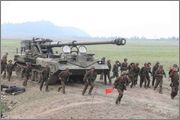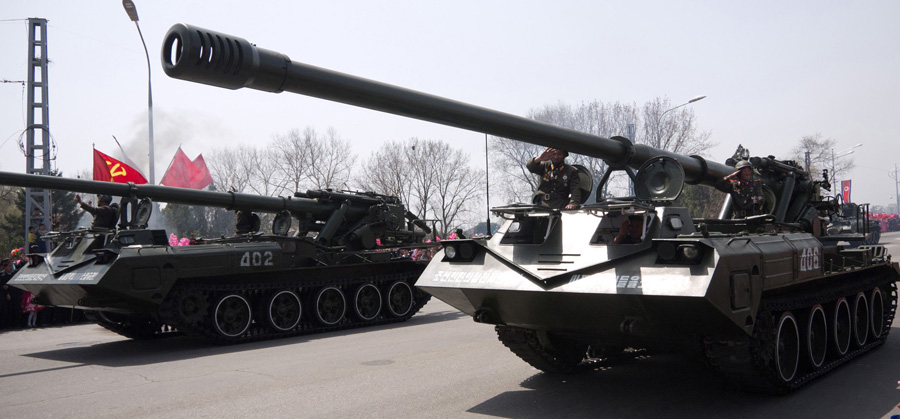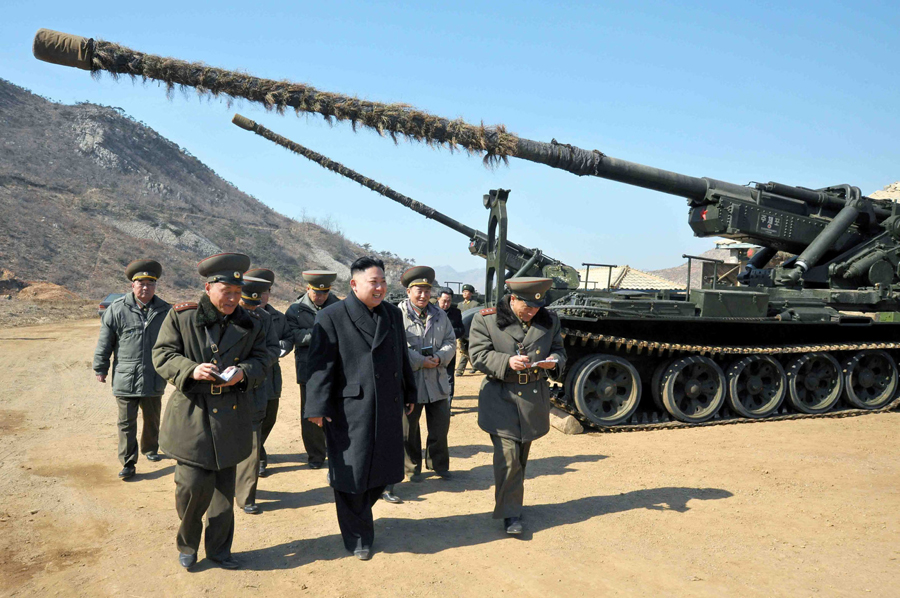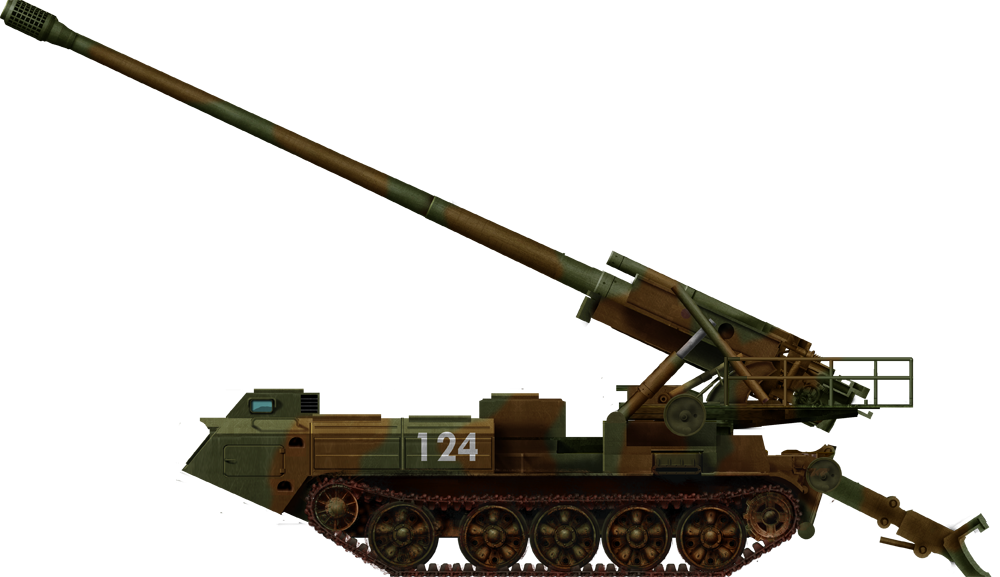About the "Juche-Po" self-propelled guns
One of the most secret and less known among world's armored vehicles are to be found with the North Korea Juche-Po program ("self-sufficiency"). The latter comprised at least a dozen of self-propelled guns mounted in a wide range of vehicles. All were designed and built in North Korea and over the years, but these are far less refined than modern turreted SPGs of Western countries or even USSR and looked like a low-cost, mass-produced solution to provide a short, medium, and long range artillery support. The Koksan was first publicly revealed in a military parade in 1985 in Koksan, hence the name.Design of the Koksan
The Koksan or 170mm Chuch'ep'o "Koksan" was first identified and labeled by US and Western intelligence in 1978, hence the M1978. The type was generally considered to be of the 170 mm caliber (6.69 inches), although a 180 mm was also identified (see later). It is based apparently on a Type 59 tank chassis, similar to the T-54A, and therefore others of the type could have been also adapted to T-54 chassis as well. The most striking and characteristic aspects of the gun compared to Western SPGs is the absence of protection, something accepted for major artillery pieces since the 1940s in the west.The gun itself was possibly derived from a Russian naval coastal battery or from a WW2 German designed later copied by USSR. For use on a tank, it was given a massive muzzle brake, a small platform was fitted as the rear base of the mount and two large and heavy uplifting spades were fitted at the rear. The latter were firmly planted in the ground when firing. It is not known however if the gun platform traverse was ever envisioned, but due to the weight of its and inevitable stability problems, it is very unlikely.
The Koksan boasted the longest range for any SPG back in the late 1970's, with 40 km with the standard two-pieced ammunitions, or 60 km using ammunitions with an additional booster (RAP round). Its estimated rate of fire is ~1-2 rounds per 5 minutes (long videos extracts are needed to confirm it). However, there was no room left for any ammunition. There was a permanent crew of four traveling with the Koksan the four others following with the ammunitions in a support vehicle. Production of this model is unknown, but based on the parade footage, satellite intelligence, and photos, it is reliably reported that North Korea has about 500 of these vehicles stationed near the DMZ within range of Seoul. Its production stopped when the new M1989 was introduced.
Variant: The M1989 and 180 mm
The M1978 is known to be a 170 mm artillery piece but a 180 mm version had been spotted, yet to be confirmed. The M1989 was introduced in 1983 and presented a lengthened chassis with a front cabin reminiscent of the Soviet 2S7 Pion, allowing to carry 12 rounds of ammunition. The crew is still of eight, four in the following vehicle. The "ready round" characteristic emphasize the need for quick operations in case of war. Unlike the M1978, the M-1989 was rarely on public display or covered by news broadcasts. According to this site, the Koksan M1978 exists in three configurations.
The Koksan in action
It has been suggested by experts that M-1978 & M-1989's equipped 12 SPG strong battalions, with 20-30 trucks and around 150 to 190 support personnel, sub-divided into three batteries of four vehicles each, plus an HQ battalion. A Brigade then represents 3 to 6 battalions, including its own HQ and organic specialized of engineers, air-defense and target data acquisition. Iran received in 1987 a supply of M1978s which saw an extensive service in the Iran–Iraq War, provided with rocket-assisted rounds. With these, Iranian forces carried out harassment fire against Kuwaiti oil fields while staying well out of reach from Iraqi artillery.These are apparently still in service in present time. Some were captured by the Iraqis however, placed on public display as trophies and later one was captured on the campus of the University of Anbar by US Marines) in 2008, allowing a unique insight of this particular North Korean vehicle. At the time the M1978 was in service indeed, this very long range capability (37 miles) made the Koksan the world's longest-ranged field artillery piece and possibly the most amazing artillery piece ever put on a T-54/Type 59 chassis ever.
Sources/Links about the Koksan
The Koksan on Wikipedia On Globalmilitary.org NK armoured vehicles on Spioenkop
Koksan specifications |
|
| Dimensions | Unclear (see sources) |
| Total weight, battle ready | Unknown |
| Crew | 4 (Driver, commander, gunner, loader) |
| Propulsion | Model 12150L V-12 liquid-cooled diesel 520hp |
| Suspension | Independent torsion bars |
| Speed (road) | Estimated 40mph |
| Range | 385 km (239 mi) |
| Armament | Main : Unidentified 170mm gun |
| Armor | Up to 100mm (hull) |
| Total production | 500 in 1978-88. |
Gallery
Self-Propelled-Gun.jpg)
Koksan M1978 ex-Iranian, ex-Iraqi, captured by US Marines on Anbar University - credits Wikipedia

Koksan M1989 in a Pyongyang Military parade, Chinese TV screenshot.

Self-Propelled-Gun-2.jpg)

Koksan M1978 170 mm (off scale)

Koksan M1989 170 mm (off scale)

Camouflaged Koksan M1989 170 mm, maximal elevation (off scale)

Cold War Tanks


































Cold war tanks posters

Cold War Main Battle Tanks

Cold War Soviet Army
Museums, Movies, Books & Games
The Tanks and Armor in pop culture
Tanks and armored vehicles in general are only really grasped when seen first person: The mass, the scale, it's all there. Explore also the way tanks were covered in the movie industry, in books and in video games.Movies:
Best tanks movie on warhistoryonline.com
On imdb.com
On bestsimilar.com/
miltours.com
liveabout.com/
watchmojo.com
Video Games:
pcgamesn.com
historyhit.com
levvvel.com
vg247.com/best-tank-games
mmobomb.com/
alienwarearena.com

